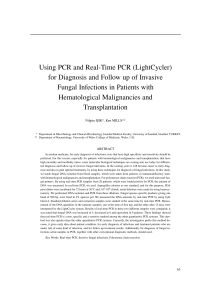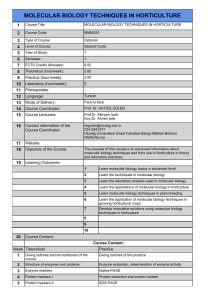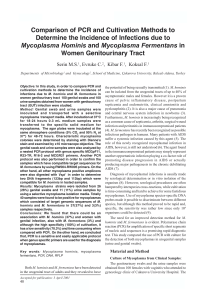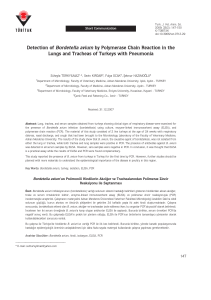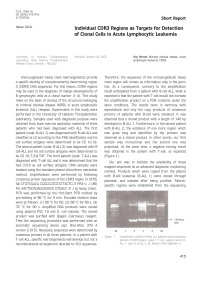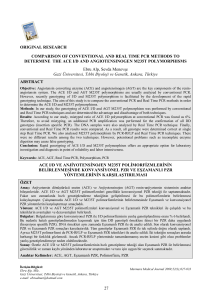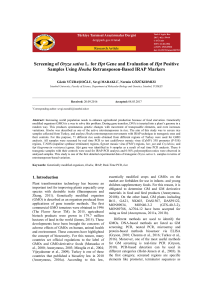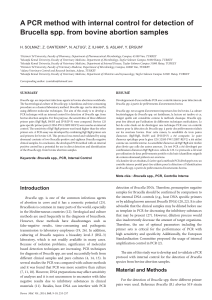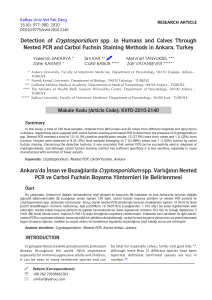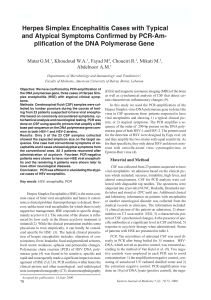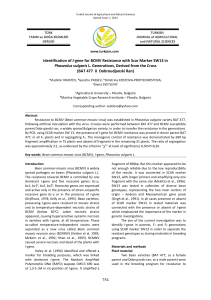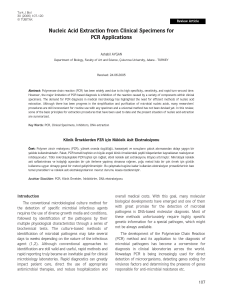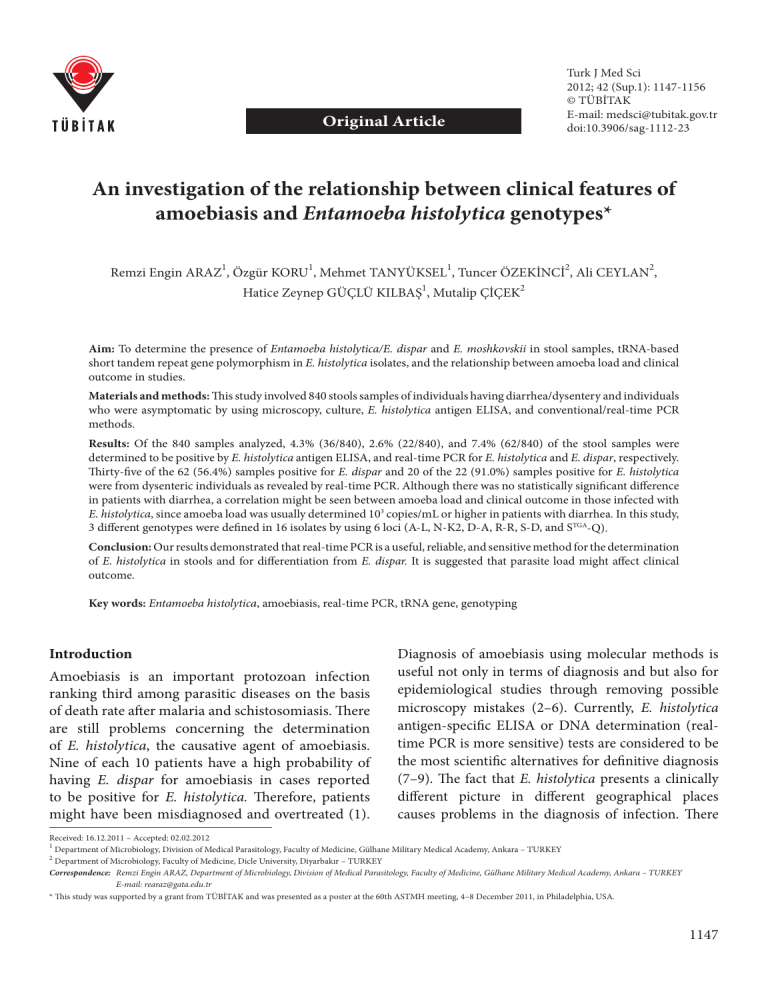
Original Article
Turk J Med Sci
2012; 42 (Sup.1): 1147-1156
© TÜBİTAK
E-mail: [email protected]
doi:10.3906/sag-1112-23
An investigation of the relationship between clinical features of
amoebiasis and Entamoeba histolytica genotypes*
Remzi Engin ARAZ1, Özgür KORU1, Mehmet TANYÜKSEL1, Tuncer ÖZEKİNCİ2, Ali CEYLAN2,
Hatice Zeynep GÜÇLÜ KILBAŞ1, Mutalip ÇİÇEK2
Aim: To determine the presence of Entamoeba histolytica/E. dispar and E. moshkovskii in stool samples, tRNA-based
short tandem repeat gene polymorphism in E. histolytica isolates, and the relationship between amoeba load and clinical
outcome in studies.
Materials and methods: This study involved 840 stools samples of individuals having diarrhea/dysentery and individuals
who were asymptomatic by using microscopy, culture, E. histolytica antigen ELISA, and conventional/real-time PCR
methods.
Results: Of the 840 samples analyzed, 4.3% (36/840), 2.6% (22/840), and 7.4% (62/840) of the stool samples were
determined to be positive by E. histolytica antigen ELISA, and real-time PCR for E. histolytica and E. dispar, respectively.
Thirty-five of the 62 (56.4%) samples positive for E. dispar and 20 of the 22 (91.0%) samples positive for E. histolytica
were from dysenteric individuals as revealed by real-time PCR. Although there was no statistically significant difference
in patients with diarrhea, a correlation might be seen between amoeba load and clinical outcome in those infected with
E. histolytica, since amoeba load was usually determined 103 copies/mL or higher in patients with diarrhea. In this study,
3 different genotypes were defined in 16 isolates by using 6 loci (A-L, N-K2, D-A, R-R, S-D, and STGA-Q).
Conclusion: Our results demonstrated that real-time PCR is a useful, reliable, and sensitive method for the determination
of E. histolytica in stools and for differentiation from E. dispar. It is suggested that parasite load might affect clinical
outcome.
Key words: Entamoeba histolytica, amoebiasis, real-time PCR, tRNA gene, genotyping
Introduction
Amoebiasis is an important protozoan infection
ranking third among parasitic diseases on the basis
of death rate after malaria and schistosomiasis. There
are still problems concerning the determination
of E. histolytica, the causative agent of amoebiasis.
Nine of each 10 patients have a high probability of
having E. dispar for amoebiasis in cases reported
to be positive for E. histolytica. Therefore, patients
might have been misdiagnosed and overtreated (1).
Diagnosis of amoebiasis using molecular methods is
useful not only in terms of diagnosis and but also for
epidemiological studies through removing possible
microscopy mistakes (2–6). Currently, E. histolytica
antigen-specific ELISA or DNA determination (realtime PCR is more sensitive) tests are considered to be
the most scientific alternatives for definitive diagnosis
(7–9). The fact that E. histolytica presents a clinically
different picture in different geographical places
causes problems in the diagnosis of infection. There
Received: 16.12.2011 – Accepted: 02.02.2012
1
Department of Microbiology, Division of Medical Parasitology, Faculty of Medicine, Gülhane Military Medical Academy, Ankara – TURKEY
2
Department of Microbiology, Faculty of Medicine, Dicle University, Diyarbakır – TURKEY
Correspondence: Remzi Engin ARAZ, Department of Microbiology, Division of Medical Parasitology, Faculty of Medicine, Gülhane Military Medical Academy, Ankara – TURKEY
E-mail: [email protected]
* This study was supported by a grant from TÜBİTAK and was presented as a poster at the 60th ASTMH meeting, 4–8 December 2011, in Philadelphia, USA.
1147
Amoebiasis clinical features and Entamoeba histolytica genotypes
are several studies indicating genetic differences of E.
histolytica (10,11). It was also shown by genotyping
that there are short repetitive structures (short tandem
repeat (STR)) inside intergenic regions between tRNA
genes of different E. histolytica strains (12,13).
There were 3 goals in this study: i) to obtain
information about the actual prevalence of
amoebiasis by the classical inspection method, E.
histolytica antigen ELISA, and E. histolytica specific
conventional/real-time PCR for stool samples,
collected from asymptomatic individuals as well as
from patients with diarrhea/dysentery in Diyarbakır,
a region considered to be endemic; ii) to determine
amoeba load for E. histolytica and E. dispar positive
patient samples by real-time PCR and to investigate
the relationship between amoeba load and clinical
outcome; and iii) to genotype via tRNA gene study of
E. histolytica positive isolates.
Materials and methods
The procedures described below were applied to
stool samples collected from individuals suffering
from diarrhea/dysentery and individuals who were
asymptomatic in the laboratories of the Department
of Medical Microbiology, Dicle University.
Stool samples were recorded, and bacteriological
culture, parasitological examination (ova and parasite
(O&P)) (0.85% NaCl and Lugol’s iodine examination,
trichrome staining, acid-fast staining, flotation
method) (14), parasitological culture (Robinson
medium), and antigen ELISA (specific E. histolytica
antigen–ELISA (TechLab E. histolytica, USA)) (15)
were used.
A commercial DNA extraction kit (Qiagen,
QIAamp DNA stool mini kit, Valencia, CA, USA)
was used for the DNA extraction as described by the
manufacturer (15).
The following tests using extracted DNA samples
were performed:
A. E. histolytica and E. dispar were determined
using real-time PCR (4,16),
B. E. histolytica and E. dispar were determined
using conventional PCR (17),
C. E. moshkovskii was detected by nested PCR
(18),
D. tRNA-STR locus PCR experiments (12).
1148
Statistical analysis
Chi-squared and kappa coefficients were used for
statistical analysis using SPSS 11.5 for Windows
(Chicago, IL, USA). Values of P < 0.05 were
considered significant.
Results
Results obtained from the analysis of stool samples
collected from a total of 840 individuals suffering
from diarrhea/dysentery and asymptomatic (no
diarrhea or dysentery) using microscopic O&P
examination, culture, E. histolytica antigen ELISA,
and molecular tests are summarized in Table 1.
The DNA samples were tested for the presence of
E. histolytica and E. dispar by real-time PCR in the
same tube. To determine the analytical sensitivity of
real-time PCR, E. histolytica (ATCC 30190) and E.
dispar (ATCC 50631) strains were diluted 10-fold.
While the sensitivity of real-time PCR was 102 copies/
mL, that of conventional PCR was 103 copies/mL.
Twenty-two samples were determined as E. histolytica
positive and 32 samples as E. dispar positive by realtime PCR. E. moshkovskii was not observed in the
samples using the conventional nested PCR analysis.
For studies of stool samples via different methods,
the ratio of Entamoeba spp. trophozoite/cyst by
microscopic method was not statistically significant
for dysenteric and asymptomatic individuals (P =
0.811). Accordingly, while there was no statistical
significance between the 2 groups for the presence
of E. histolytica according to real-time PCR (P =
0.083), there were significant differences between the
2 groups (P = 0.002 and P < 0.001, respectively) for
E. histolytica antigen ELISA and E. dispar real-time
PCR (Table 2).
For all of the samples (n = 840), there was a
significant difference (P < 0.001) between microscopy
and stool samples for the E. histolytica antigen
ELISA positivity frequency. There was no statistical
relationship (P = 1.00) between determination of
E. histolytica positive samples (n = 22) by real-time
PCR and ELISA positivity but there was a significant
difference (P = 0.002) between microscopic and
ELISA positivity for E. histolytica determined samples
by real-time PCR and for E. dispar negative samples
(n = 756) (Table 3).
R. E. ARAZ, Ö. KORU, M. TANYÜKSEL, T. ÖZEKİNCİ, A. CEYLAN, H. Z. GÜÇLÜ KILBAŞ, M. ÇİÇEK
Table 1. Results of samples collected from the study group.
Total number of samples
840
Symptom existence
Diarrhea
631
No diarrhea/dysentery problem
209
Intestinal parasite presence
129*
Stool microscopy
Erythrocyte presence
48
Leukocyte presence
41
Erythrocyte and leukocyte presence
58
Entamoeba spp. presence
84**
Results of test and cultures
Positivity of E. histolytica antigen ELISA
36
Growth in Robinson medium
21***
Positivity of bacterial culture
2
Molecular methods
Positivity of E. histolytica real-time PCR
22
Positivity of E. dispar real-time PCR
62
* Giardia intestinalis trophozoite/cyst in 44 patients, Blastocystis hominis trophozoite
in 40 patients, Cyclospora cayetanensis oocyst in 7 patients, Entamoeba coli cyst in 5
patients, Chilomastix mesnili cyst in 4 patients, Hymenolepis nana egg in 3 patients,
Iodamoeba bütschlii in 2 patients, 1 had Enterobius vermicularis; 20 patients had 2
parasites simultaneously (3 had G. intestinalis + E. coli; 6 had G. intestinalis + B.
hominis trophozoite; 5 had B. hominis trophozoite + E. coli cyst; 1 had G. intestinalis
trophozoite/cyst + C. cayetanensis oocyst; 1 had C. cayetanensis oocyst + B. hominis
trophozoite; 1 had C. cayetanensis oocyst and E. coli cyst; 2 had H. nana + E. coli
cyst; 1 had Entamoeba hartmanni cyst and B. hominis trophozoite), 3 patients had
3 parasites at the same time (Hymenolepis nana egg + B. hominis trophozoite +
I. bütschlii; B. hominis trophozoite + E. coli cyst + C. mesnili cyst; and B. hominis
trophozoite + I. bütschlii cyst + C. mesnili cyst).
** Entamoeba spp. trophozoite in only 13 of 84 patients, Entamoeba spp. cyst in 69 of
84 patients, and Entamoeba spp. trophozoite in 2 of 84 patients were determined as
a result of microscopic examination of stool samples.
***Stool samples were cultivated in Robinson medium for culture but there was no
growth, but combination with bacterial, fungal and/or other parasites was observed.
E. histolytica was not determined (denoted as negative) when experiments were
performed for DNA isolates obtained from microscopy as well as culture by
conventional and real-time PCR. E. histolytica could not be diagnosed in the xenic
Robinson medium. Therefore, the results of culture were excluded from the study
due to lack of optimization and tendency for causing misidentification.
1149
Amoebiasis clinical features and Entamoeba histolytica genotypes
Table 2. Comparison of clinical (diarrhea/asymptomatic) and microscopy (Entamoeba spp. trophozoite/cyst), antigen ELISA test for
stool samples, and E. histolytica real-time PCR results for stools samples (n = 840).
Microscopy (Entamoeba
E. histolytica
spp. trophozoite/cyst) antigen ELISA for stools
E. dispar
real-time
PCR
E. histolytica
real-time PCR
Positive
Negative
Positive
Negative
Positive
Negative
Positive
Negative
Diarrhea (n = 631)
64
567
19
612
20
611
35
596
Asymptomatic (n = 209)
20
189
17
192
2
207
27
182
P
0.811
0.002
0.083
<0.001
Table 3. Comparison of real-time PCR, microscopy, and ELISA results of stools samples.
Test results and percentage (%)
Sample groups
Microscopy
(Entamoeba spp. trophozoite/cyst)
positivity
Stools
E. histolytica antigen
ELISA positivity
All samples (n = 840)
84 (10.0%)
36 (4.3%)
P < 0.001*
E. histolytica real-time PCR positive samples (n = 22)
4 (18.1%)
4 (18.1%)
P = 1.00**
E. histolytica and E. dispar real-time PCR negative
samples (n = 756)
57 (7.5%)
29 (3.8%)
P = 0.002*
*Significant difference.
**No significant difference.
Additionally, among E. dispar real-time PCR
positive samples (n = 62), 21 samples (33.8%) were
found to be positive by microscopy (Entamoeba spp.
trophozoite/cyst) and 3 were positive (4.8%) by fecal
E. histolytica antigen ELISA.
The frequency of erythrocyte and/or leukocyte
existence in samples in which Entamoeba spp.
trophozoite/cyst was observed by microscopy was
quite high (46.4%). In addition, erythrocytes were
observed in only 1 sample that was E. histolytica
positive by real-time PCR, leukocytes were
detected in 1 sample, and erythrocytes together
with leukocytes were observed in 2 samples. No
1150
erythrocytes or leukocytes were observed by
microscopy in 18 samples. There were significant
differences and medium level coherence (P < 0.001,
kappa = 0.241) between observation of Entamoeba
spp. trophozoite/cyst by microscopy and erythrocyte
existence frequency by microscopy.
There was a significant difference and poor
coherence (P < 0.001; kappa = 0.109) between the
results of E. histolytica antigen ELISA and those of
E. histolytica real-time PCR. Real-time PCR results
were within the reference range. For E. histolytica
antigen ELISA, the sensitivity, specificity, positive
predictive value, negative predictive value, and test
R. E. ARAZ, Ö. KORU, M. TANYÜKSEL, T. ÖZEKİNCİ, A. CEYLAN, H. Z. GÜÇLÜ KILBAŞ, M. ÇİÇEK
general accuracy were calculated as 18.1%, 96.1%,
11.1%, 97.7%, and 94.0%, respectively. There was no
significant difference and poor coherence (P = 0.195;
kappa = 0.035) between the results of sample-specific
E. histolytica by microscopy and real-time PCR.
When real-time PCR results were taken as reference,
the microscopy sensitivity, specificity, positive
predictive value, negative predictive value, and
general accuracy were calculated as 97.6%, 88.3%,
18.1%, 87.7%, and 4.7%, respectively. There was no
significant difference and poor coherence (P = 0.79;
kappa = 0.060) between the results of stool sample E.
histolytica by microscopy and ELISA.
Although amoeba load was determined as 103
copies/mL both in diarrheal patients and asymptomatic individuals who were diagnosed with E. histolytica real-time PCR, the difference was not found to
be statistically significant (P = 0.089) between these
groups.
Moreover, there was no significant difference (P
= 0.064) in copy number for E. dispar real-time PCR
positive cases (n = 62) between diarrhea patients and
asymptomatic individuals (P = 0.064) (Table 4).
E. histolytica-specific primer pairs with tRNAbased polymorphic STR locus gene directed nested
PCR method was applied (Figure 1) and 3 different
genotypes were observed in the isolate. The genotypes
were named DU-1, DU-2, and DU-3 (Table 5).
1. Fourteen of 16 E. histolytica positive tRNAbased genotyped patients had diarrhea.
2. Three different genotypes were observed during
tRNA-based genotyping. The most frequently
observed genotype was DU-1 among them
(9/16). The least frequently observed genotype
was DU-2 (1/16).
3. For DU-1, 1 of the 9 patients was asymptomatic
and the rest had diarrhea. Seven of the diarrhea
patients had 102 parasite load, whereas
the remaining 1 had 103 parasite load. The
asymptomatic patient had 103 parasite load.
DU-2 genotype was only found in 1 diarrheal
patient and the parasite load was observed to
be 102. One of the 6 patients with DU-3 was
asymptomatic and the remaining 5 patients had
diarrhea. Four of the diarrhea patients had 102
parasite load but only 1 had 103 parasite load.
The asymptomatic one had 102 parasite load.
Table 4. Real-time PCR E. histolytica/E. dispar positive cases copies/numbers according to clinical
outcome.
Clinical outcome
Positive real-time PCR
E. histolytica (n = 22)
Diarrhea (n = 20)
Asymptomatic (n = 2)
Diarrhea (n = 35)
Positive real-time PCR
E. dispar (n = 62)
Asymptomatic (n = 27)
Copies/mL
Case number
10
2
2
10
3
17
104
1
102
1
10
3
1
10
2
7
103
11
104
11
10
5
3
10
6
3
102
6
103
6
10
4
7
10
5
5
106
3
1151
Amoebiasis clinical features and Entamoeba histolytica genotypes
1
2
3
4 5
6
7 8 9 10 11 12 13 14 15 16 17 18 19 D
800 bp
D-A Locus
1 2 3
4 5 6 7 8 9 10 11 12 13 14 15 16 17 18 19 D
800 bp
R-R Locus
1 2 3
4 5 6 7 8 9 10 11 12 13 14 15 16 17 18 19 D
800 bp
STGA-D Locus
1 2 3 4 5 6 7 8 9 10 11 12 13 14 15 16 17 18 19 D
800 bp
S-Q Locus
1
2 3
4 5 6 7 8 9 10 11 12 13 14 15 16 17 18 19 D
800 bp
N-K2 Locus
1
2
3 4 5 6 7 8
9 10 11 12 13 14 15 16 17 18 19 D
800 bp
A-L Locus
Figure 1. Fragment length polymorphisms in 6 loci from E. histolytica isolates, using tRNA-linked STR
array method. Line 1: 100 bp DNA marker. Lines 2 and 3: Reference isolate (HM-1:IMSS) and
negative control. Lines 4-19: E. histolytica positive isolate (7, 53, 115, 33, 77, 83, 84, 104, 132, 141,
284, 313, 317, 324, 349, and 606 numbered isolates, respectively).
1152
R. E. ARAZ, Ö. KORU, M. TANYÜKSEL, T. ÖZEKİNCİ, A. CEYLAN, H. Z. GÜÇLÜ KILBAŞ, M. ÇİÇEK
Table 5. tRNA-based genotyping of positive E. histolytica isolates from clinical samples at 6 loci.
Isolate no.
Clinical
outcome
Parasite load
(copies/mL)
D-A
A-L
R-R
N-K2
STGA-D
S-Q
Genotype
7
diarrhea
102
A
-
-
-
A
A
DU-1
33
diarrhea
102
A
A
A
A
A
F2
DU-3
53
diarrhea
10
A
-
-
-
A
A
DU-1
77
diarrhea
2
10
A
A
-
-
A
F2
DU-3
83
diarrhea
102
A
-
-
-
A
A
DU-1
84
diarrhea
102
A
-
-
-
A
A
DU-1
104
diarrhea
10
A
-
-
-
A
A
DU-1
115
diarrhea
2
10
A
-
-
-
A
F1
DU-2
132
diarrhea
102
A
A
A
A
A
A
DU-1
141
diarrhea
102
A
A
A
A
A
A
DU-1
284
diarrhea
10
A
-
-
-
A
F2
DU-3
313
diarrhea
2
10
A
A
A
-
A
F2
DU-3
317
diarrhea
103
A
-
A
-
A
A
DU-1
324
asympt.
103
A
-
-
-
A
A
DU-1
349
asympt.
10
A
-
-
-
A
F2
DU-3
606
diarrhea
10
A
-
-
-
A
F2
DU-3
2
2
3
2
2
A: same band; F1: different 1; F2: different 2; (-): no band for PCR
Discussion
In summary of the results for diagnosis in the study:
a. After examination of stool samples, 84 Entamoeba
spp. trophozoites/cysts were observed in 840
samples. E. histolytica was observed by real-time
PCR in only 4 of them and E. dispar was observed
in 21 of them. E. dispar was observed 5 times
more frequently than E. histolytica. Microscopic
examination (O&P) was not highly sensitive and
specific in every case and so it can easily lead to
misdiagnosis (especially fecal leukocyte). This
result is in accordance with previous studies
(19,20).
b. The frequency of erythrocyte and/or leukocyte
existence in Entamoeba spp. trophozoite/cyst
observed samples by microscopy was quite
high (46%). However, the erythrocytes and/or
leukocytes were observed in only 4 (18%) of the
E. histolytica positive samples by real-time PCR.
c. Separately, in 129 patients 1, 2, or 3 intestinal
parasites were observed at the same time. Eightyfour patients had typical intestinal parasites such
as G. intestinalis and B. hominis. This revealed
that not only E. histolytica but also other parasites
should be taken into consideration in diarrhea
cases.
d. A significant difference and poor coherence were
obtained for samples in terms of E. histolytica
antigen ELISA and specific E. histolytica real-time
PCR results. ELISA shows weakness in comparison
with microscopy for amoebiasis diagnosis.
This result was consistent with other studies in
the literature (21,22). The differentiation of E.
histolytica from E. dispar is crucially important
1153
Amoebiasis clinical features and Entamoeba histolytica genotypes
for the definitive diagnosis of amoebiasis, and the
real-time PCR is a reliable method for this.
e. As a result, while microscopy and stool antigen
ELISA have low sensitivity (18% for both
methods), ELISA has higher specificity (96.1%)
than microscopy has (87.7%) with respect to
the real-time PCR method. In particular, the
low sensitivity of ELISA is conspicuous and in
accordance with the study performed by Stark et
al. (23).
A precise diagnosis requires that the same
reaction conditions are used for standardization.
Real-time PCR is an attractive technique for
laboratory diagnosis of infectious diseases because of
its characteristics that eradicate post-PCR analysis,
leading to shorter turnaround times, with a decrease
in contamination of laboratory environments and
reduced reagent costs (24). In a report about a travel
clinic, microscopy and antigen ELISA served as
initial screening tests, and stool samples with negative
results in these tests were not subjected to PCR
analysis or to serological testing. Therefore, a number
of patients with Entamoeba spp. infections may not
have been detected as such (25). In patients in whom
only 1 sample was collected, the clinical course
and probable complications were not monitored
and the laboratory results (E. histolytica/E. dispar
existence and tRNA-based genotype determination)
were compared with the presented clinical pictures
(diarrhea/dysentery/asymptomatic) only as done in
the literature (26,27). In the present study, a tRNAbased genotyping study was performed for the first
time in Turkey.
The amount of DNA of the organism was a
key factor for the success of tRNA-based genotyping.
In this study, parasite load of E. histolytica positive
patients’ isolates was determined as 102 and 103. As
a result of this, tRNA-based genotyping studies
of all E. histolytica isolates were not performed.
Determination of conventional PCR method as
negative for E. histolytica diagnosis and highly
sensitive real-time PCR results show parallelism with
several studies (2–5,21) and validate our estimation
about the method discussed in the sense of its being
a more reliable test than the others.
The results of the molecular studies performed in
the second part are as follows:
1154
a) It is thought that real-time PCR was more
feasible because of its determination of 2 amoeba
species (E. histolytica and E. dispar) in a single tube
and having high sensitivity (single tube real-time
PCR method provides determination of parasite
load in the concentration of 102 copies/mL) because
conventional PCR has sensitivity of 103 copies/mL.
b) In 55 individuals with diarrhea, E. histolytica
was detected in 20 individuals while E. dispar
was detected in the remaining. However, in 29
asymptomatic individuals, E. histolytica and E. dispar
were detected in 2 and 27 of them, respectively. As
a result, while E. histolytica causes diarrhea as a
symptom, it was worthy of note that E. dispar was
determined at an almost equivalent rate in individuals
having diarrhea as well as in asymptomatic
individuals. It was expected that symptom formation
such as diarrhea was high with respect to number of
copy/mL in terms of parasite load intensity according
to the clinical results. Diarrhea was determined more
in samples diagnosed with E. histolytica by real-time
PCR clinically; in addition, although amoeba load
was determined as 103 copy/mL most frequently in
diarrhea patients (17 of 20 patients), there was no
significant difference in terms of copies number. The
majority (22 of 35) of the diarrhea patients in which
E. dispar was detected by real-time PCR had a parasite
load of 103 and 104 copies/mL. Although similar (103
copies/mL) or higher parasite loads were detected for
E. dispar by PCR in asymptomatic individuals, it was
observed that this finding was not associated with the
disease process.
c) Three different genotypes were defined in 16
isolates by using 6 loci after tRNA-based genotyping
was performed. E. histolytica was determined in
approximately 2.6% of diarrhea/asymptomatic
individuals via real-time PCR, and so tRNA
genotyping of these gave 3 different genotypes.
Existence of isolates having different genotypes
even in close geographical location can cause
formation of symptoms in different ways. Due to
the limited amount of pure parasite DNA recovery
after extraction in direct parasite detection, it must
be considered that DNA recovery after cultivation,
instead of direct testing, would allow increasing the
number of genotypes. This was confirmed by the
existence of these kinds of problems regarding tRNA
R. E. ARAZ, Ö. KORU, M. TANYÜKSEL, T. ÖZEKİNCİ, A. CEYLAN, H. Z. GÜÇLÜ KILBAŞ, M. ÇİÇEK
analysis in other studies (26,27). In a study involving
a tRNA-based method, 3 genotypes were determined
by using 3 STR loci (D-A, A-L, and R-R) in 6 samples
in Turkey and it was observed that these genotypes
are different than ones in Georgia (28). In a study by
Ali et al., 16 isolates from Bangladesh, 1 from Italy,
and 1 from the USA were examined and they found
that D-A, A-L, and S-D loci were successful, N-K2
and R-R loci were less successful, and S-Q locus was
unsuccessful due to multiple bands (27). In a Japanese
study, 8 genotypes were observed in clinical isolates
from 12 diarrhea/dysenteric patients and a genotype
was discovered having similarity with that from
asymptomatic cases (26). As with other intestinal
protozoa, molecular detection and genotyping are
also important for E. histolytica (29,30).
In a study performed in a certain region of
Turkey with a relatively low number of isolates,
it was concluded that there might exist different
genotypes and these genotypes could play a role
in diarrhea formation; the parasite load of 102 and
higher may contribute to diarrhea formation but
there was no certain rule for this; and finally there
might be asymptomatic individuals having higher
loads of parasite as observed only for 1 individual in
this study. There was another conspicuous point in
the present study that conventional PCR has some
limitations in cases of low parasite load in some
individuals and so there might be some problems in
diagnosis and treatment. Because of these reasons,
highly sensitive and specific methods such as realtime PCR should be regarded as the reference test
for an accurate and reliable diagnosis. Another
important point was that symptoms such as diarrhea
were observed in some E. dispar infected individuals.
This indicated the necessity for a detailed E. dispar
genotyping based investigation contributing to
amoebiasis pathogenesis (31).
In conclusion, there are different strains in the
same region and this may affect clinical aspects
(diarrhea). As a consequence, immensely large scale,
deliberate and organized molecular epidemiological
studies are required not only to determine the
reason for asymptomatic or symptomatic (diarrhea
or dysentery) amoebiasis but also for diagnosis
and to understand the pathogenesis and virulence
of E. histolytica strains showing high degrees of
heterogenetic causes.
Acknowledgments
The authors wish to thank Assoc Prof Dr Cengizhan
Açıkel MD (Gülhane Military Medical Academy,
Department of Epidemiology) for his kind assistance
with the statistical analyses of the data, and Suzan
Esin and Fatma Karakaya for their lab technical
assistance. The authors also wish to thank Prof Tülin
Karagenç for her critical reading of the manuscript.
References
1. Tanyuksel M, Petri WA Jr. Laboratory diagnosis of amebiasis.
Clin Microbiol Rev 2003; 16: 713–29.
2. Gonin P, Trudel L. Detection and differentiation of Entamoeba
histolytica and Entamoeba dispar isolates in clinical samples
by PCR and enzyme-linked immunosorbent assay. J Clin
Microbiol 2003; 41: 237–41.
3. Blessmann J, Ali IK, Nu PA, Dinh BT, Viet TQ, Van AL et
al. Longitudinal study of intestinal Entamoeba histolytica
infections in asymptomatic adult carriers. J Clin Microbiol
2003; 41: 4745–50.
4. Verweij JJ, Blange RA, Templeton K, Schinkel J, Brienen EA,
van Rooyen MA et al. Simultaneous detection of Entamoeba
histolytica, Giardia intestinalis, and Cryptosporidium parvum
in fecal samples by using multiplex real-time PCR. J Clin
Microbiol 2004; 42: 1220–3.
5. Kebede A, Verweij JJ, Endeshaw T, Messele T, Tasew G, Petros
B et al. The use of real-time PCR to identify Entamoeba
histolytica and E. dispar infections in prisoners and primaryschool children in Ethiopia. Ann Trop Med Parasitol 2004; 98:
43–8.
6. Blessmann J, Buss H, Nu, PA, Dinh BT, Ngo QT, Van AL et al.
Real-time PCR for detection and differentiation of Entamoeba
histolytica and Entamoeba dispar in fecal samples. J Clin
Microbiol 2002; 40: 4413–7.
7. Tanyuksel M, Petri WA Jr. Amebiasis, eds: Rakel RE, Bope ET,
In: Conn’s Current Therapy. Saunders Elsevier, Philadelphia;
2006; p 66–71.
1155
Amoebiasis clinical features and Entamoeba histolytica genotypes
8. Haque R, Kabir M, Noor Z, Rahman SM, Mondal D, Alam F
et al. Diagnosis of amebic liver abscess and amebic colitis by
detection of Entamoeba histolytica DNA in blood, urine, and
saliva by a real-time PCR assay. J Clin Microbiol 2010; 48:
2798–801.
21. Kurt O, Demirel M, Ostan I, Sevil NR, Mandiracioglu A,
Tanyuksel M et al. Investigation of the prevalence of amoebiasis
in Izmir province and determination of Entamoeba spp. using
PCR and enzyme immunoassay. New Microbiol, 2008; 31:
393–400.
9. Othman N, Mohamed Z, Verweij JJ, Huat LB, Olivos-Garcia
A, Yeng C et al. Application of real-time polymerase chain
reaction in detection of Entamoeba histolytica in pus aspirates
of liver abscess patients. Foodborne Pathog Dis 2010; 7: 637–
41.
22. Santos HL, Peralta RH, de Macedo HW, Barreto MG, Peralta
JM. Comparison of multiplex-PCR and antigen detection for
differential diagnosis of Entamoeba histolytica. Braz J Infect Dis
2007; 11: 365–70.
10. Ayeh-Kumi PF, Ali IKM, Lockhart L, Petri WA Jr, Haque R.
Entamoeba histolytica: Genetic diversity of clinical isolates
from Bangladesh as demonstrated by polymorphisms in the
serine-rich gene. Exp Parasitol 2001; 99: 80–8.
11. Tanyüksel M, Ulukanlıgil M, Yılmaz H, Güçlü Z, Araz E, Mert
G et al. Genetic variability of the serine-rich gene of Entamoeba
histolytica in clinical isolates from Turkey. Turk J Med Sci 2008;
38: 239–44.
12. Ali IK, Zaki M, Clark CG. Use of PCR amplification of tRNA
gene–linked short tandem repeats for genotyping Entamoeba
histolytica. J Clin Microbiol, 2005; 43: 5842–7.
13. Clark CG, Ali IKM, Zaki M, Loftus BJ, Hall N. Unique
organisation of tRNA genes in Entamoeba histolytica. Mol
Biochem Parasitol 2006; 146: 24–9.
14. Garcia, LS, Bruckner DA. Diagnostic Medical Parasitology,
Third edition, ASM Press, Washington DC; 1997; p 608–50.
15. Roy S, Kabir M, Mondal D, Ali IKM, Petri WA, Jr, Haque R.
Real-time PCR assay for diagnosis of Entamoeba histolytica
infection. J Clin Microbiol 2005; 43: 2168–72.
16. Qvarnstrom Y, James C, Xayavong M, Holloway BP, Visvesvara
GS, Sriram R et al. Comparison of real-time PCR protocols for
differential laboratory diagnosis of amebiasis. J Clin Microbiol
2005; 43: 5491–7.
17.Clark CG, Diamond LS. Differentiation of pathogenic
Entamoeba histolytica from other intestinal protozoa by
riboprinting. Arch Med Res 1992; 23: 15–6.
18. Ali IK, Hossain MB, Roy S, Ayeh-Kumi PF, Petri WA Jr,
Clark CG. Entamoeba moshkovskii infections in children in
Bangladesh. Emerg Infect Dis 2003; 9: 580–4.
19. Haque R, Faruque AS, Hahn P, Lylerly D, Wilkins T, Petri WA
Jr. Entamoeba histolytica and E. dispar infection in children in
Bangladesh. J. Infect. Dis, 1997; 175: 734–6.
20. Haque R, Ali IKM, Akhter S, Petri WA Jr. Comparison of
PCR, isoenzyme analysis, and antigen detection for diagnosis
of Entamoeba histolytica infection. J Clin Microbiol 1998; 36:
449–52.
1156
23. Stark D, van Hal S, Fotedar R, Butcher A, Marriot D, Ellis J
et al. Comparison of stool antigen detection kits to PCR for
diagnosis of amebiasis. J Clin Microbiol 2008; 46: 1678–81.
24. Tengku SA, Norhayati M. Public health and clinical importance
of amoebiasis in Malaysia: A review. Tropical Biomedicine
2011; 28: 194–222.
25. Herbinger KH, Fleischmann E, Weber C, Perona P, Löscher
T, Bretze G. Epidemiological, clinical, and diagnostic data on
intestinal infections with Entamoeba histolytica and Entamoeba
dispar among returning travelers. Infection 2011; 39: 527–35.
26. Escueta-de Cadiz A, Kobayashi S, Takeuchi T, Tachibana H,
Nozaki T. Identification of an avirulent Entamoeba histolytica
strain with unique tRNA-linked short tandem repeat markers.
Parasitol Int, 2010; 59: 75–81.
27. Ali IK, Solaymani-Mohammadi S, Akhter J, Roy S, Gorrini C,
Calderaro A et al. Tissue invasion by Entamoeba histolytica:
evidence of genetic selection and/or DNA reorganization
events in organ tropism. PLoS Negl Trop Dis 2008; 2: e219.
28. Tanyuksel M, Ulukanligil M, Toprak M., Ali IKM, Araz E, Guclu
Z et al. A route of genotyping of Entamoeba histolytica: t-RNA
gene studies, 5th European Congress on Tropical Medicine and
International Health, Amsterdam, 2007, 12: suppl 1, 149.
29. Hatam Nahavandi K, Fallah E, Asgharzade M, Mirsamadi
N, Mahdavipour B. Glutamate dehydrogenase and triosephosphate-isomerase coding genes for detection and genetic
characterization of Giardia lamblia in human feces by PCR and
PCR-RFLP. Turk J Med Sci 2011; 41: 283–9.
30. Usluca S, Aksoy Ü. Detection and genotyping of cryptosporidium
spp. in diarrheic stools by PCR/RFLP analyses. Turk J Med Sci
2011; 41: 1029–36.
31. Ximenez C, Cerritos R, Rojas L, Dolabella S, Morán P,
Shibayama M et al. Human amebiasis: breaking the paradigm?
Int J Environ Res Public Health 2010; 7: 1105–20.

